|
===================================================
How To Break 80 Newsletter
April 11, 2007
"The Web's Most Popular Golf Improvement Newsletter"
===================================================
In this issue we'll discuss...
1) Forward Shaft Lean
2) Retaining Spine Angle
3) Question of the Week-
Maintaining the Left Elbow
4) Article- Avoiding the
"Line of Charm"
5) Article- Six Steps To Pull Off The 25-foot Lob
===================================================
1) Forward Shaft Lean ===================================================
Ball-first contact is mandatory if you want to hit your irons like a pro. How do you know if you’re making ball first contact? Look at your divots. If you're making ball-first contact, your divots will come after the point of impact, which means your hitting the ball with a descending blow. If you start your divots before impact, you're not making ball-first contact, which means you're not hitting the ball with a descending blow.
The key contributor to a descending blow is forward shaft lean—the angle of your shaft when striking the ball. The club's shaft must be leaning forward at impact for a solid hit. Forward shaft lean "traps" the ball against the ground, rather than "scooping" it with the club. Combine forward shaft lean with the proper release of the hands and you'll make solid contact with your irons every time.
Below are two drills that foster good iron play. The first teaches you forward shaft lean. The second encourages good release of the hands.
Headcover Drill
By placing a headcover behind the ball about a foot and slightly inside the target line, you can learn to strike the ball with a descending blow, achieving the correct forward shaft lean. Start with practice swings without the ball, concentrating each time on hitting the turf on the target side of the headcover without making contact with it. Once you feel comfortable doing this, place a ball in front of the headcover and hit some shots. If you swing with a scooping motion, you'll hit the headcover first.
Release Drill
To learn to rotate the club properly through impact, focus on freeing your hand action in the backswing and downswing. Imagine hiding your bottom hand with your top hand as the club passes through impact. With practice, you'll ingrain the feeling.
Work on these two drills and you'll find yourself hitting your irons like a pro and not slicing the ball. Remember ball-first contact is mandatory and forward shaft lean is the key to ball-first contact.
==================================================
2) Retaining Spine Angle
==================================================
The body angles created at address—known as posture—influence the shape and quality of your swing. If you achieve and maintain the correct body angles at address, you'll have a better chance of hitting a good shot. If you don't achieve and maintain good angles, your chances of hitting a good shot are slim and none. No body angle is more important than your spine angle.
Spine angle is key because it’s the axis around which your body turns. The turning of your body creates the torque you need to power the ball, whether you're hitting from the tee box or the fairway. But sometimes in the last few seconds before starting your swing, the golfer throws his spine angle—and the rest of his set-up—off by making some small movement, like turning the head to take one last look at the target.
But there's an alternative movement to viewing the target that helps maintain your spine angle. In the last few seconds before swinging, turn your chin instead of your head to view the target. Turning your chin toward the target enables you to retain the proper body position and spine angle, without adjusting your weight, shoulders, or hands. When you turn your head, you inevitably lift it, open your shoulders, and lose sight and feel of what the correct position should be.
Remember to turn your chin, not your head, to view the target, whether hitting a wood or an iron. It will keep your spine angle—and setup—in place. And watch those small movements just prior to hitting the ball. They can throw your swing—and your consistency—off.
=================================================== 3)
Question of the Week- Maintaining the Left Elbow
===================================================
From Thomas
Maintaining the Left Elbow
Q: Hi! I have read many of your articles and they're very useful in improving my game. I have a question about my golf swing. Lately, I have been plagued with elbow break- down at impact and follow-through. I have been working on trying to keep my left elbow straight but sometime it breaks down during the backswing. I keep getting mixed messages about the left arm in the backswing. Some instructors say to keep your arm straight during the backswing (make a wider arc) for more distance. Some say you don't have to keep it straight during the backswing. It only matters when you're at the impact area when the arm needs to be straight. Is there any suggestion or advice you can give me? Thanks.
A: Your left arm (for a right-hander) must be straight at impact to hit the ball well. A straight left arm during the backswing is another matter. If you can keep it straight through the backswing, you'll produce more distance because your swing radius is wider. But some people because of age, a lack of flexibility, injury, or what have you must bend the left arm a little during the backswing. That’s okay, as long as the rest of the swing is sound.
Sometimes a bent left arm is the result of over swinging, caused by an out-of-position right arm (for a right-hander). In addition to intentional swinging to hard, the two main causes of over swinging are:
1) losing control of your grip at the top of your swing, or 2) an unnatural width of your backswing because of a malfunctioning right arm.
The right arm controls the width of the swing arc. If the angle of the gap at the top of the swing between the right forearm and the right biceps is less than 90 degrees, you’ve over swung, forcing the left arm to bend in the process. An ineffective coiling of the torso often accompanies the over swinging.
The key to shortening your swing is re-establishing the correct width of your backswing arc. To do this, your right elbow must form a right angle as it folds back at the top of the swing, forming an “L” shape. In this position your left arm is comfortably straight (not tense) and your club is parallel to the ground, assuming you hinge your wrists correctly. From there it is simply a matter of bringing the club down straight through impact.
If you've got a golf question you'd like answered, send an email to us at
questions@howtobreak80.com and we'll review it. I can't guarantee that we'll use it but if we do, we'll make sure to include your name and where you're from.
===================================================
If you want to truly discover the secrets of shooting like the Pros and creating a more reliable and consistent swing, check out:
http://www.HowToBreak80.com
P.S. Feel free to share this newsletter with family and friends. If you
would like to subscribe to this newsletter, send a blank email to
break80ezine@aweber.com
===================================================
About the Author
===================================================
Jack Moorehouse is the author of the best-selling book
"How To Break 80 and Shoot Like the Pros!". He is NOT a golf pro, rather a working man that has helped thousands of golfers from all seven continents lower their handicaps quickly. His free weekly newsletter goes out to thousands of golfers worldwide and provides the latest golf tips, strategies, techniques and instruction on how to improve your golf game.
|
Tools To
Help Your Game!
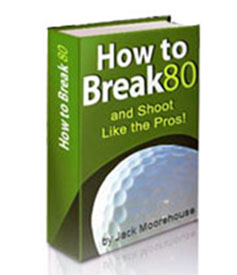
eBook
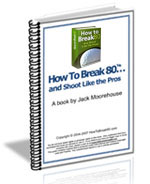
Physical Book
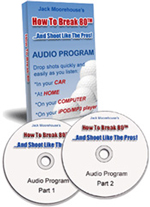
Audio Program
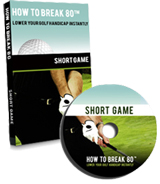
Short Game DVD
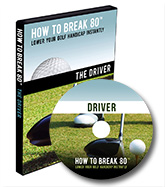
Driver DVD
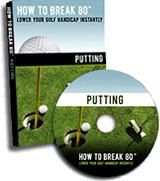
|